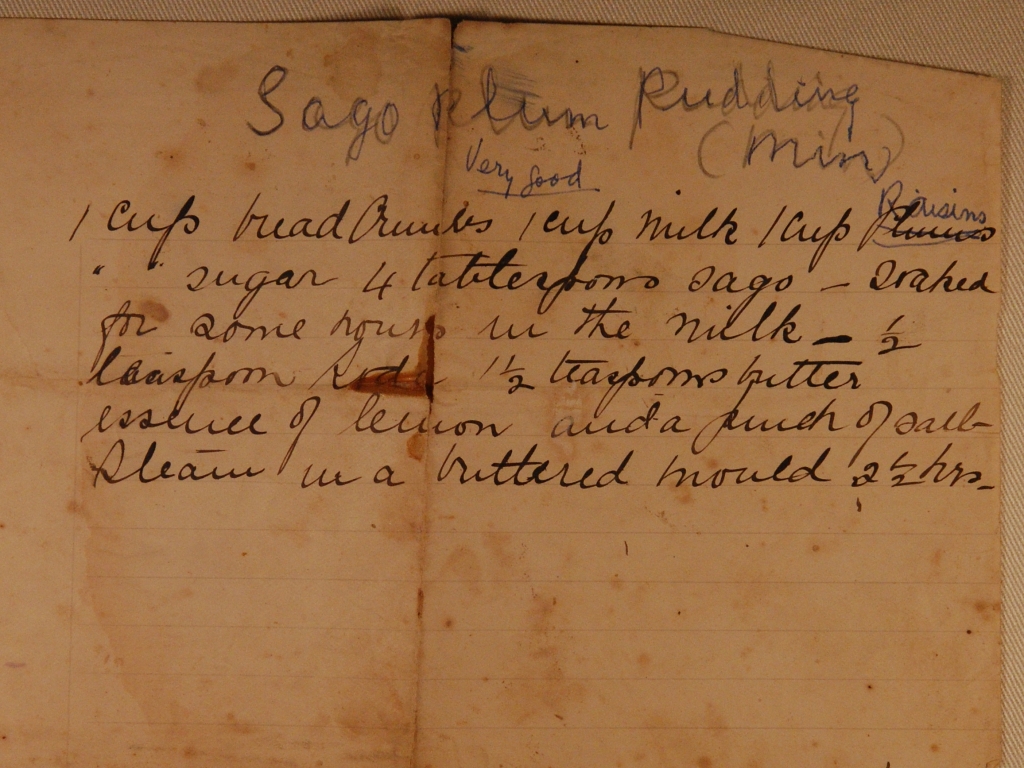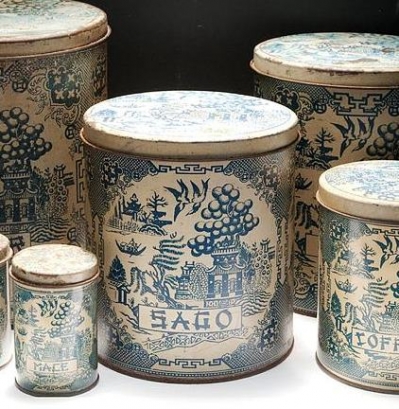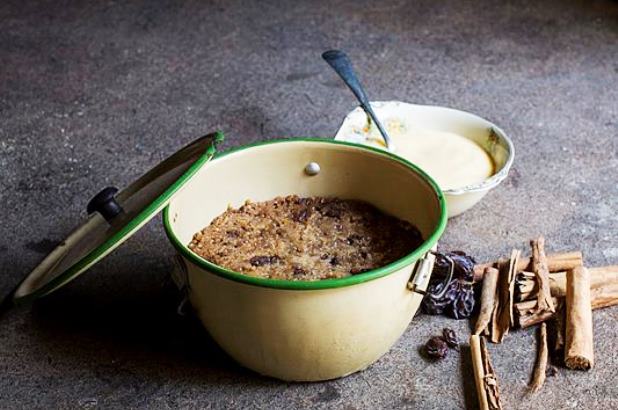With the winter solstice almost upon us my thoughts shift to foods that warm and nourish the soul. The Christmas style plum pudding was always intended as mid-winter fare and this variation on the plum pudding theme is simple to make, rich tasting and truly comforting to eat.
-

Handwritten recipe for sago plum pudding. Meroogal collection, Sydney Living Museums.
An heirloom recipe
The sago pudding recipe above is from the Meroogal collection, handwritten on a blank page in the back of a cookbook which dates from the early 1900s. You can see that it has been updated and annotated in an elderly hand so that it wouldn’t be overlooked by the next generation’s cooks. Sago plum pudding (metricised recipe below) is warming and comforting but not as rich as an egg-rich plum pudding, the sago giving a moist but light texture. It is delicious with vanilla custard or icecream.

Willow sago canister c.1920s. Private collection Photo © Jamie North (detail)
Sago on tap[ioca]
As we’ve discussed before, sago was a pantry staple in many Australian households which has slipped from view since the mid-1900s. Sago and its very similar alternative tapioca, were valued for their glutinous, jelly-like consistency once cooked, and being relatively cheap, were used in cold summer puddings, to add bulk to desserts. Favourites were sago snow, lemon sago – a cold pudding and sago custard. Sago replaced eggs in some dessert dishes, so was very useful in winter when hens weren’t laying, or as an austerity measure during wartime or the Great Depression.
Sago plum pudding
Ingredients
- 50g (1/4 cup) sago
- 250ml (1 cup) milk
- 225g (1 cup) white granulated sugar
- 2 teaspoons butter, softened
- 1 cup raisins (or sultanas)
- 1 teaspoon lemon extract (or substitute vanilla extract, ground nutmeg or mixed spice)
- 90g (1 1/2 cups) breadcrumbs made from 2-day-old white bread, crusts removed
- 1/2 teaspoon bicarbonate of soda
- boiling water
Note
This pudding is among the many dessert dishes from the early 1900s found in the manuscripts held at Meroogal. It is by no means an 'instant pudding' – the sago needs to be soaked for several hours and the pudding itself needs to steam for 3 hours – but it keeps very well and can be made in advance. The lengthy cooking time creates a rich treacle-like flavour.
Serves 4–6
Directions
| Soak the sago in the milk overnight in the fridge. Grease a 1-litre (4-cup) capacity pudding basin, or equivalent smaller bowls, with butter. Cut a round of baking paper the same size as the rim of the bowl. Prepare a double layer of foil to form a 2-cm pinch pleat along the centre, allowing for pressure as the pudding cooks. Put a trivet in the base of a saucepan that is deep enough to hold the pudding basin while still able to be covered with the saucepan lid. Mix the sugar, butter, raisins, lemon extract, breadcrumbs and a pinch of salt together in a mixing bowl. Stir the bicarbonate of soda into the milk and sago mixture then add to the dry ingredients, mixing all together lightly. Pour the mixture into the pudding basin. Cover the surface of the pudding with the paper and cover the basin with the foil, tying securely with string. Put the basin on the trivet in the pan and add enough boiling water to reach halfway up the side of the basin to create a water bath. Cover the pan and boil the pudding for 3 hours, topping up with boiling water as needed. | |
| Remove the basin from the pan and allow the pudding to rest for 30 minutes before serving. For a more rustic dessert, serve the pudding straight from the bowl or, if turning it out onto a plate, run a spatula around the sides of the bowl before inverting it to ensure the pudding comes out intact. Delicious with custard or ice-cream. | |
| COOK'S TIP: A pudding bowl with a fitted lid makes the steaming process easier, but foil works just as well. | |

 Print recipe
Print recipe

